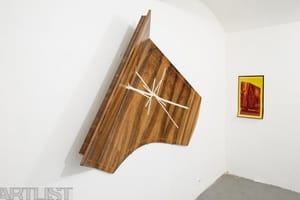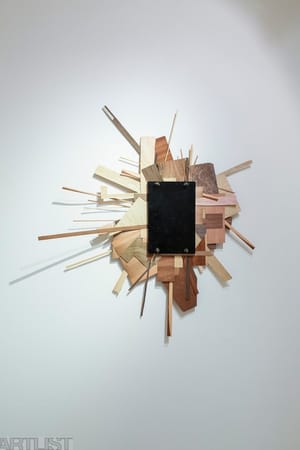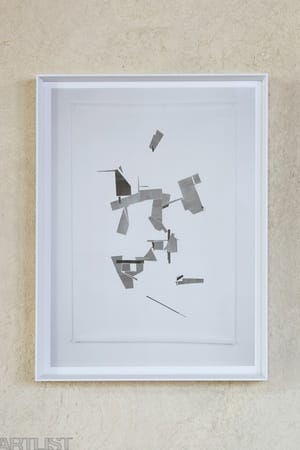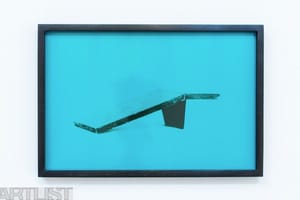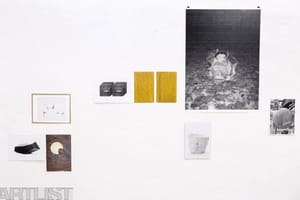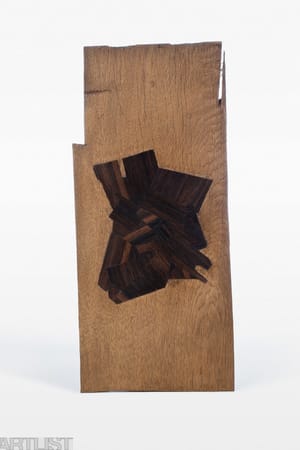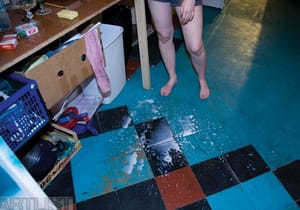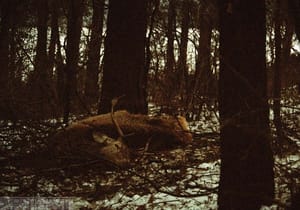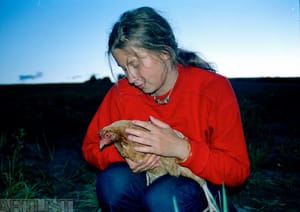- First Name
- Peter
- Surname
- Fabo
- Born
- 1983
- Birth place
- Sušice, CZ
- Place of work
- Prague
- Keywords
- CSU Library
- ↳ Find in the catalogue
About artist
Peter Fabo is an artist with strong experience in the medium of photography, and although he has not given up on it, his development of visual reflection has led him to new processes of painting, object and installation.
His first photographic artist book Diana (2008) and his diploma work Name, City, Animal, Thing (2010) are akin to each other in their compressed intimate energy, combining individual photographs into a compelling entity. In Diana, the artist chooses almost exclusively portraits of his girlfriend, or occasionally of things which are related to their co-existence. The images have variable technological origins and it took six years to collect them. Already here, a complex visual situation arises, which is later further developed in gallery installations. The photographs are not in chronological order but they are connected by intuitive manipulation with the continuity of individual pictures, their mood, colour, composition and relative contrast. Although the work appears as a book, its contents can be read in different ways - one set of images transforms into a specific magical cycle for each viewer, it is a hypertextual thought system.
The book Name, City, Animal, Thing has a similar character. Again, it can be read (viewed) as well as sensed. The images used here also revolve around one person. It is not an object, however, but a subject of the photographer who chooses the motifs and creates the narrative line. In both books, Fabo works with an archive and reinterprets the content by putting it in a different order, which is an aspect that permeates through all his work.
For Peter Fabo, actual photography, beginning with the choice of a theme, then exposure and ending with developing or digitalization is just the first part of an entire process. Following this he uses individual shots as building blocks for the construction of more complex systems and interprets them in a way where he finds new relations between them. Fabo uses this method of installation in the medium of a book, which he later remoulds into the medium of an exhibition. The photographs function as material units which, through their aesthetic qualities, constitute relationships between themselves and a specific gallery environment. The exhibition project Contact through a Contact Copy (2014) combines the locality of a room that has large windows facing south with a set of photographs varying in size, technique and theme, which become coherent only after they are arranged together in the given room. The artist covered some parts of the windows with foil, which broke up the regular geometry of window frame shadows. This intervention created an image of light which formed a new synthesis with the individual photographs. Another author’s book, Peter Fabo 2013, works as a blueprint for this exhibition. It no longer has the function of a subjective document, but of an encyclopaedia of inspirations of Fabo’s overall work, as well as individual pieces of works.
The book Peter Fabo 2013, presents reproductions of photographs along with a documentation of wooden objects and intarsia. Fabo has been working intensely with intarsia – a traditional and today rather unusual technique - since approximately 2012. This time and skill demanding process consists of inlaying pieces of differently coloured and structured veneers which merge to form a mosaic-like picture with an illusion of depth.
With his use of intarsia, Fabo’s accidence acquires a new formal language of abstract geometry. His inspiration comes undeniably and admittedly from cubism and constructivism, but Fabo also brings post-modern elements into the whole game. For instance, the title of his work Crystal Cherry (2012) not only refers to the motif, but also to the origin of the wood out of which the intarsia was crafted. Therefore, the reading of these artworks offers us a balance on the border of translation between form and content.
Similarly to how in his individual artworks geometrical elements form a balanced whole, these pieces of work are considerately combined into the medium of an exhibition. Fabo further develops his postmodern game here by combining modernistic language with unusual, sometimes even ironic elements. The exhibition Varnish (2014) brings a layered whole where the faint brownish colour of wood works together with the striking wall painting from the CMYK colour model. However, there are conceptual gestures anchored within this peculiar artistic landscape, which sensitively emerge from the abstract shapes – for example the word COOL in one of the geometrized intarsia. The exhibition L O N G E R (2015) in the KIV gallery further develops this reflection of interaction between form and content. This spectacular composition looks like an environment, with its details referring to one another and serving the function of being a guide for the viewers. However, the undue presence of a banana in the constructivist intarsia makes the composition and its connotations questionable, similarly to, for example, the cow in Malevich’s cubist composition Cow and Violin (1913) from over one hundred years ago.
In his exhibitions, Fabo works with multi-layered artistic and content relationships, the understanding of which is made easier precisely by their formal peculiarity and refinement.
- Author of the annotation
- František Fekete
- Published
- 2015
CV
1998-2002 Secondary Technical School, Department of Stone-sculpture, Spišská Nová Ves, Slovakia
2004-2010 College of Applied Arts in Prague, studio photo
Internships:
2007 - Academy of Arts in Prague, studio typography
2007 - Facultad de Bellas Artes de Granada, Spain
2009 - University of Art and Design - Cluj Napoca, Romania
Exhibitions
- Solo exhibitions
-
2015
Lakuj, galerie SET, Liberec
čočo #2, galerie A.M. 180, Praha
2014
Kontakt skrze kontaktní kopii, galerie Entrance, Praha
2013
Superstár, galerie Kytka, Praha
čočo, City Surfer Office, Praha
Cesta sa v zime neudržuje, Berlínskej Model, Praha
2011
DOMINANTY, galerie Photoport, Bratislava
Meno, Mesto, Zviera, Vec, Galéria Umelcov Spiša, Spišská Nová Ves
REM, galerie Lumen, Budapešť
Príloha inzerátu, galerie Fotograf, Praha
2010
Muchy a jablko späť, galerie 207, Praha
2008
Druhá strana, galerie Velryba, Praha
- Group exhibitions not included in ARTLIST.
-
2015
Delta, České centrum, Berlín
2014
Foto Festival, Muzeum Moravská Třebová
Výstava o židli, Bienále fotografie a vizuálního umění, Liege, Belgie
2013
3, galerie Kvalitář, Praha
Martina Pešková Peter Fabo, galerie studijní a vědecké knihovny v Hradci Králové
2012
Geologický prieskum, galerie 35m2, Praha
2011
Obraz ve kterém žijeme, GASK, Kutná Hora
Obraz ve kterém žijeme, galerie Emila Filly /Armaturka/, Ústí Nad Labem
LAB EAST / LABOR OST, galerie V8, Cologne, Německo
Erotická Revue, galerie GASK, Kutná Hora
In optima forma, galerie Emila Filly /Armaturka/, Ústí Nad Labem
2010
Rodinný pocit, Dom fotografie, Liptovský Mikuláš, Slovensko
Šraml fest Znojmo, Holy Pilgrimage of Cyril & Method II
LAB EAST / LABOR OST, Curych, Švýcarsko
Semana Santa, Átrium Café, Spišská Nová Ves
Pixel, Muzeum umění a designu, Benešov
2009
Situácie ktoré sa mohli stať, Café bar Vítkov, Praha
Dve izby, galerie (A)VOID, Praha
Pixel, galerie Velryba, Praha
Twilight zone, Divadlo Underground, Praha
2008
To nepodstatné, galerie Mánes, Praha
Maska, Horažďovice
2007
Šestka, Pražský dům fotografie, Praha
2006
Nie iba jedna, ale veľa izieb, GAVU, Praha
2005
120. výročí VŠUP, galerie Mánes, Praha
Světlo, Česká národní banka, Praha

